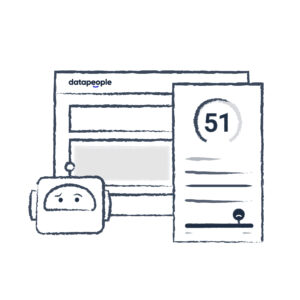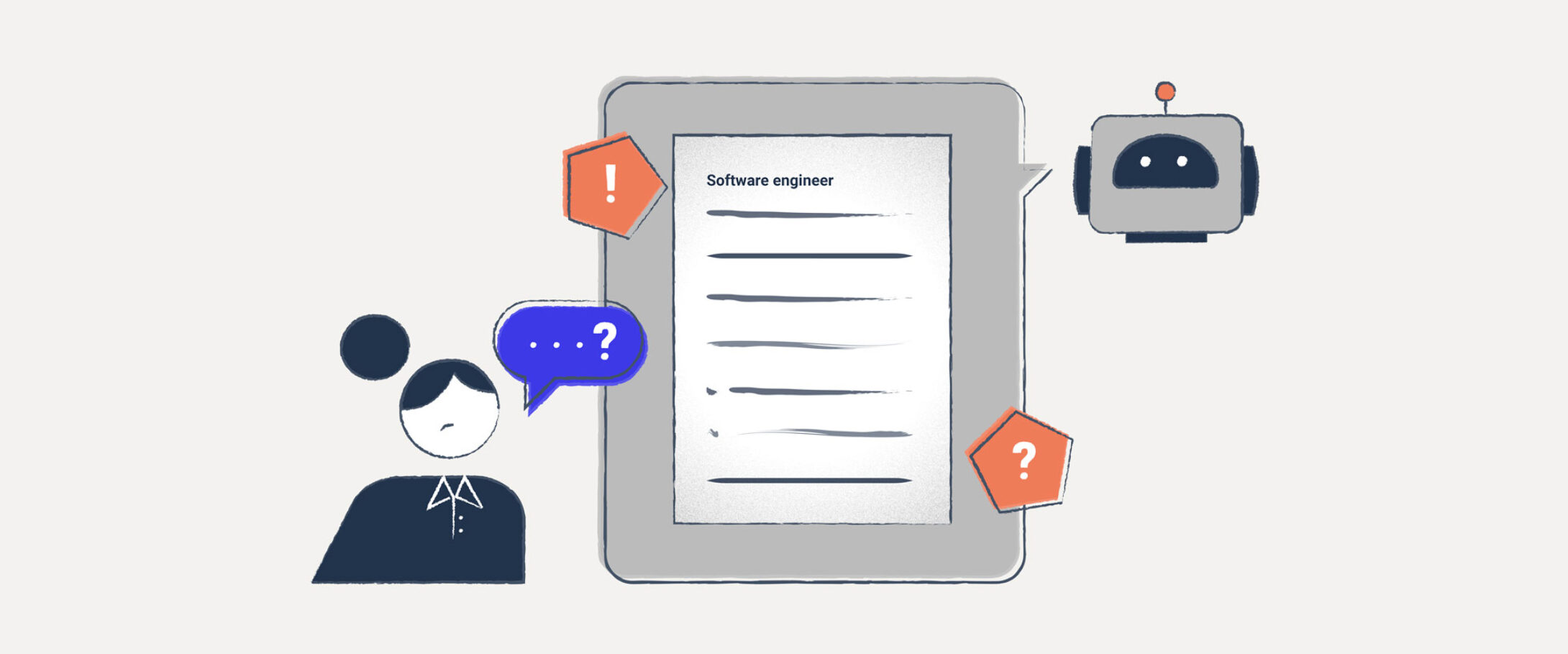Before using generative AI for job ads, remember just how unique job ads are. They’re technical, with a real devil in the details. (The title alone can make or break your hiring effort.) They’re also full of nuance. (A lot of content isn’t inherently good or bad, inclusive or exclusive until you place it in the context of the job ad.) And they require intelligence. (The most effective ones are based on data, not intuition.)

But job ads are also the most important piece in hiring efforts. They’re often the only messaging a job seeker reads from your company. They have to advertise the opening, accurately describe the role, and introduce your company all at the same time.
Job ads have a measurable impact on hiring. An inclusive, data-informed job ad will attract a larger, more qualified, and more diverse talent pool, translating into a successful hiring process. A bad job post may leave you with few or no qualified applicants, translating into an unsuccessful hiring process (i.e., one that ends in no hire, which is the case for 31% of all requisitions).
Bottom line, job ads are really complex and important pieces of content to trust entirely to a generative AI tool. You can use AI for job ads, but in a discerning, responsible way. We’ll explain.
The (many) limitations of AI for job ads
No doubt generative AI will advance dramatically in the coming years. But at this point its limitations are many and varied when it comes to recruiting. Its role in writing job ads, outreach emails, and the like should be a minor one.
Bias in, bias out
Artificial intelligence based on probability is only as good as the data it’s trained on. An AI tool trained solely on effective, inclusive job ads could, hypothetically, write effective, inclusive job ads.
But at the moment there aren’t any generative AI tools (that we know of) trained exclusively on job ads proven to successfully attract qualified and diverse candidate pools. Instead, the tools available look to the internet for examples. Sound familiar? It’s where a lot of humans look for examples of job ads.
One problem with this approach (for both AI tools and humans) is that it perpetuates whatever biases exist in the examples. Another problem is that it perpetuates the job ad echo chamber, where every job ad reads like every other.
We don’t mean to pick on anyone, but here’s ChatGPT on using ChatGPT in recruiting:
“It is important for organizations to ensure that the data used to train the model is diverse and unbiased, and to regularly evaluate and monitor the performance of the model to ensure fairness.”
“While we have safeguards in place, the system may occasionally generate incorrect or misleading information and produce offensive or biased content. It is not intended to give advice.”
“ChatGPT is only as good as the data it’s trained on and the quality of questions it’s given.”
The black box

Artificial intelligence is often a bit of a black box in that it can be difficult or impossible to explain its outcomes. You know a bunch of data goes in and a bunch of things happen to get an outcome, but you don’t see any of it. (That’s why it’s important to choose responsible AI partners, like Datapeople, that prioritize transparency with interpretable models that can be understood, inspected, and explained.)
Generative AI doesn’t always get it right, even when it sounds perfectly confident. These “hallucinations” can be dead wrong, but they’re packaged in confident, authoritative language. An AI tool generating a job ad may recommend unnecessary requirements that sound legit. Not only won’t you know why it included those requirements – you may not even think to question them. (Or their impact on your applicant pool, or hiring process.)
AI’s vanilla job ads
Generative AI’s main skill at this point is mimicry, but that’s a problem when it comes to job ads. Today’s job seekers want to read ads that speak to them directly, and a vanilla job ad isn’t going to attract them. Bottom line: the job ad echo chamber doesn’t make good, data-driven job ads that attract qualified, diverse applicant pools and result in a more efficient hiring process.
Intellectual property rights and AI for job ads
When generative AI borrows ideas, who owns the content created by it? It’s still early in the AI era, and the question of intellectual property hasn’t been worked out in the courts yet. We don’t know where the laws will come down regarding the ownership of AI-generated content.
How Datapeople uses AI
Datapeople’s job description software uses AI, but in a responsible way to ensure fairness, predictability and interpretability. We combine AI, natural language processing, data science, and behavioral science.

We train our model specifically on data from millions of real-world jobs and their outcomes, not a broad-based dataset. And we don’t leave the advice of our platform to probability, which can lead to bad advice (e.g., unnecessary requirements).
Rather, we think it’s vital that humans oversee every piece of guidance in Datapeople. And we consider bias and fairness at every step – from the training data we ingest to how we interpret the data in our guidance.
An AI tool doesn’t have recruiting industry knowledge and doesn’t know what makes an inclusive, effective job ad. We do, so we bake our industry data and expertise into Datapeople and only use AI to help out. (Again, a human hand touches every piece of our platform.) Because of that, among other benefits, our guidance is interpretable and explainable.
ChatGPT-written job ads in Datapeople
So what happens when you use AI for job ads? We asked ChatGPT to write some ads and candidate outreach emails for us. We copied and pasted them into Datapeople and received a lot of tips. Here are some of the highlights.
Sales Development Representative
First question asked to ChatGPT: “Write a job description for a sales development representative.”
From Datapeople:
- “Your job is very likely to underperform.”
- “Unnecessary requirements like ‘attention to detail’ are easily misunderstood and reduce overall applicant quality.”
- Rating on the Inclusion Meter: Exclusive
Second question asked to ChatGPT: “Write an outreach recruiting email to a possible candidate for a sales development representative role.”

From Datapeople:
- “The difference between ‘hard work’ and ‘overworked’ can be difficult for qualified candidates to distinguish.”
- “Language that emphasizes ‘self-motivation’ or ‘independence’ is easily misunderstood and reduces overall applicant diversity.”
- Rating on the Inclusion Meter: Exclusive
Java Backend Software Engineer
Question asked to ChatGPT: “Write a job description for a Java backend software engineer.”
From Datapeople:
- “Your job is very likely to underperform.”
- “Job seekers have a strong preference for ‘you’ language.”
- “Language that emphasizes the ‘competitiveness’ of benefits often implies ‘below-market’ to candidates.”
- Rating on the Inclusion Meter: Exclusive
Templates (and Datapeople) already solve for writer’s block
Perhaps the biggest advantage of generative AI is that it helps writers get started. Recruiters and hiring managers can use it to write the first draft of a job post, then tweak the draft to their company and role. (That’s a necessary step because AI doesn’t know the ins and outs of your company and can’t write sufficiently specific content for you.)

But job templates do that already and, in fact, provide a better starting point because they come with important content baked right in. With templates, recruiters and hiring managers don’t have to write job posts from scratch or hunt down recent company info like the latest diversity statement, benefits, or compensation philosophy.
Everything is already in there, accurate and approved. (With new pay transparency laws constantly cropping up, this means peace of mind for both hiring team members and recruiting leadership.)
Instead, job ad writers can focus solely on the content that relates to the particular job (role details, requirements, and qualifications). Which means they can create a meaningful document quickly.
At the same time, templates ensure content and brand consistency across your entire organization. All of your job ads paint the same picture of your company (the one you want). Job seekers use the picture to decide up front whether to opt in or opt out of your recruiting process – saving everyone time and effort.
In Datapeople, recruiting and recruitment marketing leaders can set up templates and tailor their templates to various job types (e.g., remote versus on-site). Hiring teams can even go beyond a template, starting with a complete job that’s similar to the one they’re advertising and go from there.
And writer’s block isn’t the only hurdle
Again, job ads are technical documents with nuanced language. Getting them right requires real-world data, not intuition.
Unlike generative AI, Datapeople offers guidance on content and language proven to work, not just something that sounds like it works. Our guidance is based on millions of hiring outcomes, not just other job ads, along with data science and behavioral research.
Datapeople actually teaches hiring teams how to write better job ads. They get real-time intelligence that helps them make informed decisions – in the moment. Datapeople might identify an obscure qualification that could reduce the talent pool. Or it might remind them to add critical content proven to attract qualified candidates, leading to a more efficient and successful hiring process overall. Those aren’t things that generative AI can do yet.
Potential uses of AI for job ads
Having said all that, generative AI can help, just in a limited way.
How you can use generative AI for recruiting:
- Writing the first draft of a job ad if you don’t already have a library of templates. (Hiring managers at smaller companies may find that particularly useful.)
- Composing less impactful items like emails and social media ads.
- Helping any hiring teams writing in a non-native language. (For example, if you have a team in Brazil hiring for English-speaking roles.)

With these caveats:
- You will have to “humanize” your AI-generated content. (Again, AI doesn’t know your company or how to emotionally connect with humans.)
- You will need to optimize your job ad in a platform like Datapeople. Our Smart Editor not only solves the garbage-in-garbage-out problem, it also helps hiring managers and recruiters understand the impact of their choices in real time.
- For example, including an MBA requirement isn’t necessarily a bad or biased thing. But it could limit your applicant pool depending on the job type and location, rendering the entire hiring process less efficient.
Yes and no. Generative AI can help you with first drafts of job ads and less impactful communications like outreach emails and social media posts. It can help if your company doesn’t have a library of job ad templates already. And it can help teams writing in a non-native language.
However, it can’t write inclusive, effective job ads. Because, simply put, it doesn’t know what makes an inclusive, effective job ad. A platform like Datapeople combines millions of real-world job outcomes with data science and behavioral science. It provides actionable guidance that, over time, actually teaches hiring teams how to write better job ads. That’s just not something that a generative AI tool can do right now.
Should hiring teams use generative AI for job ads?
In the end, if you want to use generative AI for job ads, you can. Just make sure you’re aware of its limitations and the extra work you’ll need to do to make your job ads and other communications inclusive and effective. For more tips on incorporating generative AI into your job post creation process – and your hiring process overall – watch Perspectives on Generative AI’s Transformation of Talent Acquisition, our webinar with leading industry analyst Tim Sackett.
Here at Datapeople, we’ve spent years studying what makes job posts work, and learned that the best ones are no accident. We’ve also learned that while this intentionality isn’t always easy, it’s worth it. Smart job posts have an outsized impact on the efficiency, fairness, and success of your overall hiring process.
We’ve compiled a number of data-backed best practices – informed by our findings from over 65 million job ads and millions of hiring outcomes – into a free checklist that you can share with all the recruiters and hiring managers in your organization. Download it now to systematically improve job ads (and hiring success) across your business.
